



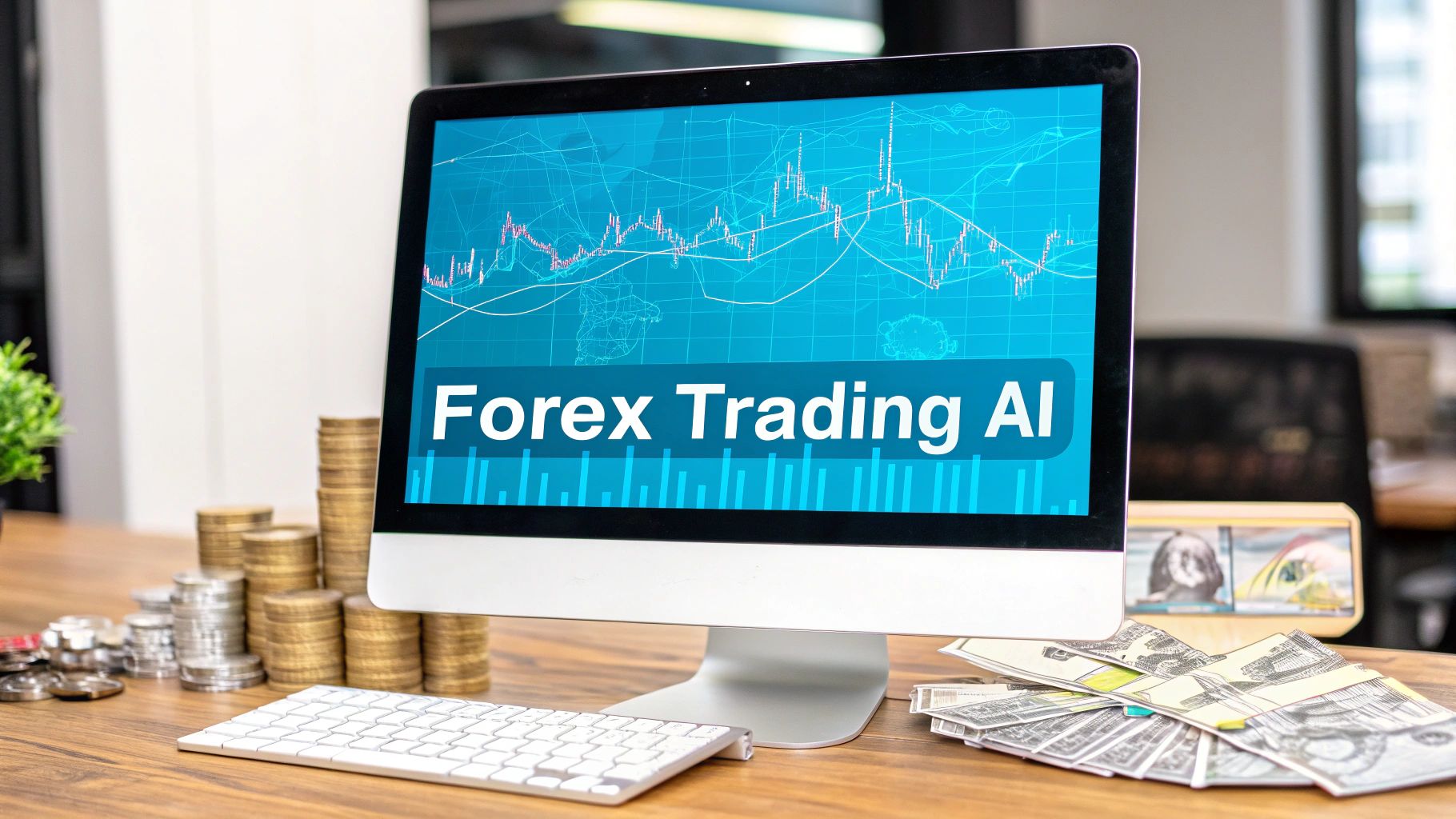
So, what does it actually mean to use AI in forex trading? It's about bringing in smart software to crunch huge amounts of market data, spot profitable patterns, and make trades faster and more accurately than any human ever could. It’s a game-changer that shifts your trading strategy from just reacting to the market to actively predicting its next move.
Let's get one thing straight: this isn't about sci-fi robot traders taking over. Think of AI as a practical, powerful tool that’s already making a real impact on the foreign exchange market. It’s less about a futuristic fantasy and more about gaining a serious analytical edge right now. This technology gives traders a massive advantage by digesting information and acting on it with incredible speed.
Imagine a classic trader trying to navigate the market with a map and compass. They’re relying on historical charts, their gut feeling, and a handful of trusted indicators to plot a course. It’s a proven method, for sure, but it’s limited by what one person can see and process at any given time.
Using AI for forex trading is like swapping that map for a live satellite feed of the entire planet. You're no longer just looking at one path—you see every road, every traffic jam, and every storm front all at once. This bird's-eye view comes from AI’s ability to:
This isn't just a niche tool anymore; it's becoming the standard. The numbers back it up: 65% of traders across the globe feel that AI and machine learning give their results a boost. Even more telling, a staggering 88% of profitable traders use automated bots for analysis and execution. To dive deeper, you can explore more forex trading statistics and see their full impact.
The real magic of AI isn’t just about putting your trading on autopilot. It's about enhancing your own intelligence. It does the heavy lifting with the data, freeing you up to focus on the big picture—your overall strategy and how you manage risk.
At the end of the day, AI helps cut through the noise. It takes chaotic market data and turns it into clear, actionable insights, giving you a much better handle on potential opportunities and risks. This guide will walk you through exactly how to put this technology to work for you, no matter your experience level.
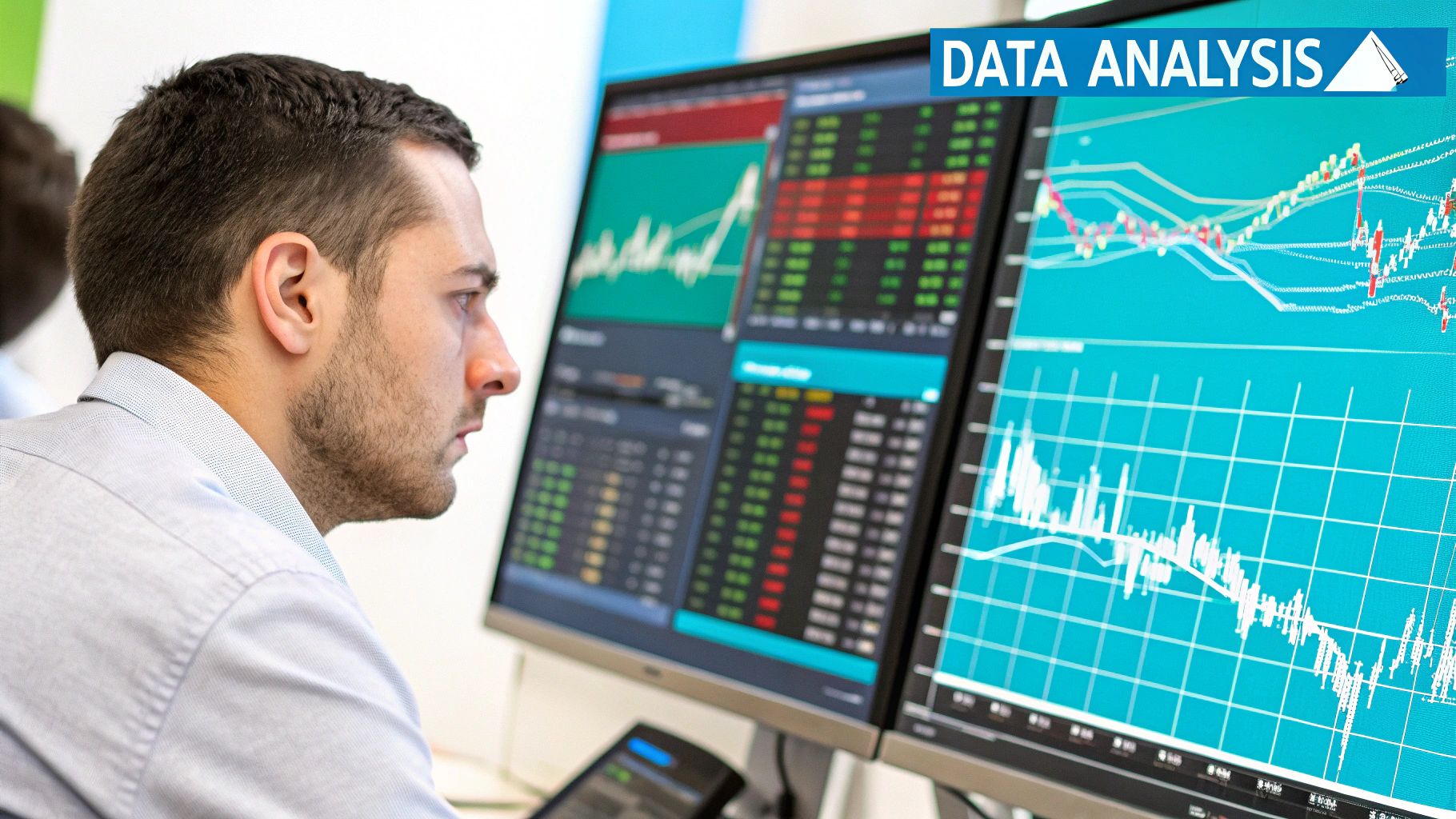
To really get what AI brings to the table in forex trading, you have to peek behind the curtain a bit. Don't worry, you don't need a PhD in computer science. Just think of AI as a group of highly specialized apprentices, each trained to see the market in a slightly different way. These are the different types of AI models, and each has a job to do.
It all starts with the basics: Machine Learning (ML). Picture yourself handing a new trading intern a stack of thousands of historical forex charts. You walk them through it, pointing out which patterns led to winning trades and which ones were losers.
After a while, that intern starts spotting those patterns without your help. That’s exactly what Machine Learning does. It plows through massive amounts of historical price data, teaching itself to find the recurring patterns, correlations, and indicator signals that often come right before a big market move.
An ML model is essentially trained to answer one key question: "Given what the market looks like right now, what's happened most often in the past?" It's a powerful way to build predictive models that are grounded entirely in historical performance.
This is the bedrock of many AI trading tools you see today. It’s fantastic for tasks like:
Of course, this apprentice is only as good as the history books it studies. That’s why rigorous backtesting is so critical. You can get a better sense of this by reading a guide on backtesting your trading approach. It’s the only way to be sure the patterns the AI finds are solid and not just statistical flukes.
Now, imagine that instead of just one apprentice, you had a whole team of seasoned specialists. That’s the idea behind Neural Networks, which are a much more sophisticated form of Machine Learning. A neural network is built to mimic the human brain, with layers of interconnected "neurons" that all work together.
Each layer in the network gets a different assignment. The first layer might just look at raw price action. The next might be an expert on momentum, while another focuses solely on volatility. By putting their heads together, this team can spot incredibly subtle, complex relationships in the data that a simpler ML model would completely miss.
Neural networks don't just see the patterns; they begin to understand the context. This helps them adapt to shifting market dynamics much better than rigid, rule-based systems.
This makes neural networks perfect for tackling the really tough problems. For example, an AI powered by this tech can analyze how interest rate news, inflation reports, and raw price action are all interacting at the same time to drive a currency’s value.
Finally, we know that not everything that moves the market shows up on a chart. Political bombshells, central bank statements, and even viral social media posts can send currencies swinging. This is where Natural Language Processing (NLP) steps in.
Think of NLP as an AI that can read and understand human language—at superhuman speed. It scans millions of news articles, tweets, and economic reports every single second to get a feel for the market's mood. Is the sentiment around the US Dollar turning bullish? Is there growing fear about the Eurozone?
By turning all that chatter into hard data, NLP adds a layer of analysis that charts simply can't provide. It helps traders understand the why behind a sudden move, not just the what. This allows an AI system to react instantly to a surprise headline, often before the move is even visible on the chart, giving its user a massive head start.
Okay, let's move past the theory and talk about what really matters: how using AI for forex trading gives you a real-world edge. This isn't just about cool technology; it's about getting tangible advantages that address the biggest headaches traders deal with every single day.
At its heart, AI brings a level of discipline and analytical horsepower that a human brain just can't match. It shifts trading from something often driven by gut feelings and emotion to a process powered purely by data, speed, and relentless analysis.
Every trader has been there. You close a trade too early because of fear, or you hang onto a losing position way too long, hoping it'll turn around. These emotional decisions are probably the single biggest account killer. AI doesn't have fear, greed, or hesitation—it just follows the rules and patterns it's been taught.
Picture this: the EUR/USD pair takes a nosedive. A human trader might panic and sell, only to watch it whip back up. An AI, on the other hand, instantly cross-references that drop with historical data, volatility metrics, and key support levels. If its algorithm sees the move as a classic shakeout before a rally, it will hold its ground or even spot a buying opportunity, completely unfazed by the market panic.
The forex market operates at lightning speed. Opportunities can appear and disappear in the blink of an eye. AI systems can process incoming data, spot a valid setup, and execute an order in a fraction of a second. No human can compete with that. This kind of precision is what gets you the best possible entry and exit prices.
This isn't a niche advantage anymore; it's changing the entire industry. By 2025, it's predicted that Artificial Intelligence will be behind roughly 89% of all global trading volume. The market for AI trading tools is also expected to hit an estimated $35 billion valuation by 2030, which shows just how deeply this tech is being adopted.
This infographic breaks down the difference between an AI-driven approach and the old-school manual way.
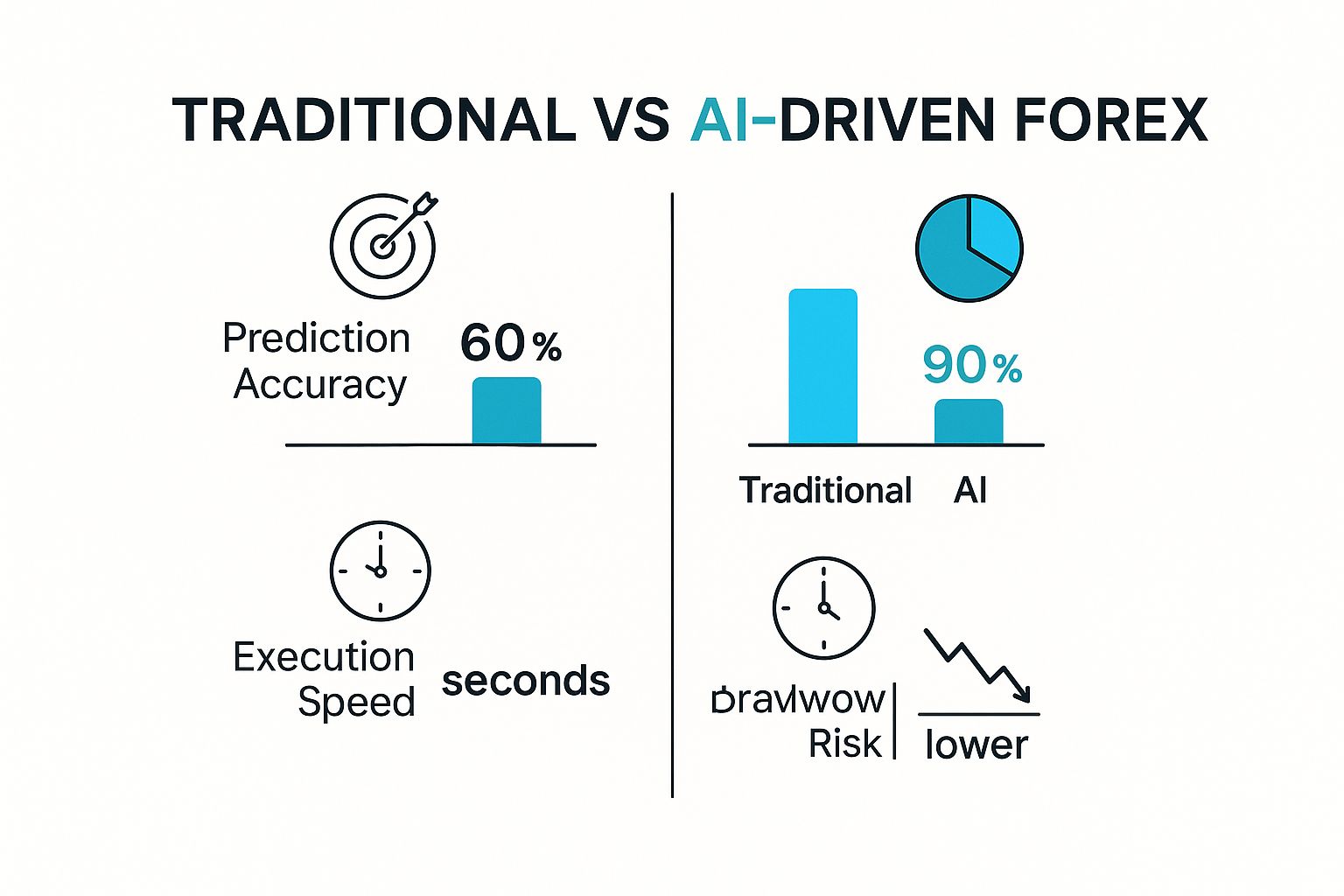
As you can see, the numbers point to huge gains in accuracy, speed, and risk management when you let AI do the heavy lifting.
To make this crystal clear, let's compare the two approaches side-by-side.
The takeaway is simple: AI isn't just a slightly faster version of a human trader. It operates on a completely different level of scale and efficiency.
Human traders are taught to look for classic chart patterns, but an AI can find thousands of faint, complex patterns that are completely invisible to us. It might notice a tiny correlation between a minor currency pair's volatility and a slight move in a major stock index, flagging a trade hours before it becomes obvious to everyone else.
These systems are brilliant at uncovering hidden relationships in the data that traditional technical analysis just can't see, giving you an information advantage. To get a better feel for this, you can learn more by checking out our guide on understanding AI trading signals.
An AI doesn't just see the market; it perceives it in multiple dimensions. It analyzes price, volume, news sentiment, and economic data simultaneously to build a complete picture of market dynamics.
The forex market never sleeps, but people have to. This is where AI becomes a game-changer. It can watch the markets for you around the clock, covering every session from Tokyo to London to New York.
It never gets tired, never gets distracted, and never misses a crucial move that happens while you're away from your screen. This means your strategy is always on, constantly scanning for opportunities and managing risk so you don't have to be glued to your charts 24/5.
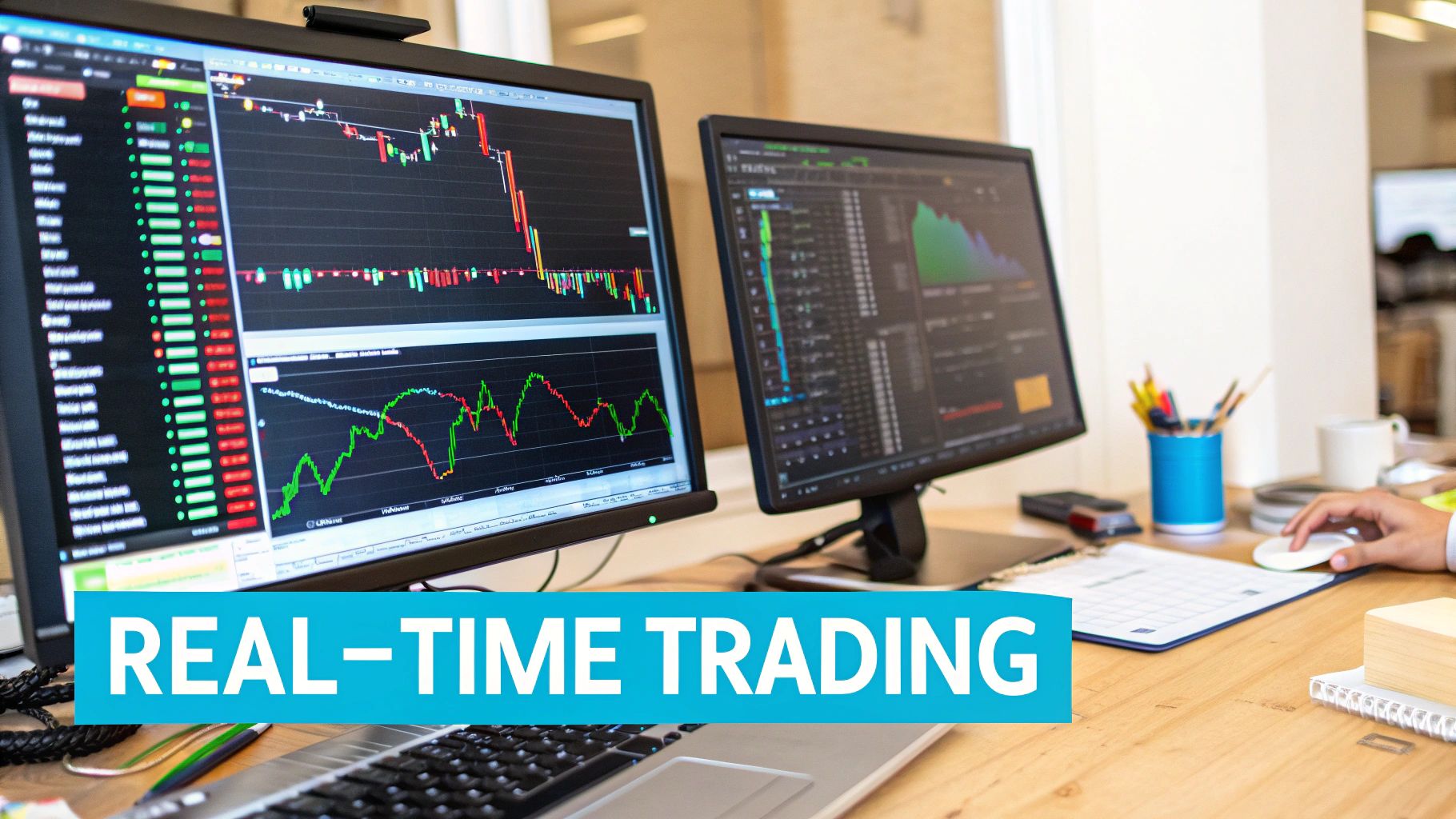
Knowing that AI for forex trading is powerful is one thing, but actually putting it to work is what matters. The great thing is, you don't need a degree in data science or some complicated server setup anymore. Modern tools are built to plug right into the platforms you're already familiar with, turning abstract AI theory into real, actionable signals on your charts.
The trick is to think of these AI tools as an incredibly smart assistant, not a replacement for your own judgment. They do the heavy lifting—all the number crunching and data sifting—so you can focus on the big picture: strategy, risk management, and confirming the high-probability setups the AI flags for you. Let's walk through how to make this a natural part of your trading routine.
First things first, you need a solid charting platform that plays well with third-party AI indicators. For millions of traders, the undisputed champion is TradingView. It's intuitive, packed with features, and serves as the perfect hub for blending classic technical analysis with specialized AI tools.
With your platform sorted, you need an AI engine. This is where tools like EzAlgo enter the picture. Instead of trying to build your own algorithms from scratch, you can subscribe to a service that gives you a whole suite of pre-built, battle-tested AI indicators. This approach has some serious perks:
It's a bit like getting a top-tier navigation app for your car. You don't build the satellite network yourself—you just install the app and get real-time traffic updates and the fastest route.
Getting a tool like EzAlgo hooked up is a refreshingly simple process. If you’re already comfortable with TradingView, you’ll feel right at home.
Here’s what the setup usually looks like:
The screenshot above gives you a perfect example of what this looks like in practice. It's a standard price chart, but it's been supercharged with clear buy and sell signals, dynamic support and resistance zones, and momentum gauges—all generated by the AI. This gives you immediate context, pointing out key areas of interest you might have otherwise overlooked.
Once the AI tool is live, your chart will be filled with new information—buy/sell alerts, trend clouds, reversal signals, you name it. The biggest mistake you can make is to just follow these signals blindly. A pro uses them as a powerful confirmation tool.
An AI signal should be treated as a highly informed suggestion, not an unbreakable command. The strongest trade setups occur when the AI's analysis aligns perfectly with your own technical or fundamental outlook.
For example, say your own analysis points to a potential long trade on USD/CAD because it's bouncing off a key support level. If your AI indicator then flashes a "Buy" signal right in that same spot, your confidence in that trade just shot through the roof. The AI just crunched thousands of data points in a split second and came to the same conclusion you did.
This is where the real magic happens. You’re combining your human intuition and strategic mind with the AI's raw analytical horsepower. By doing this, you start filtering out the weaker signals and focusing only on the A+ opportunities, leading to a much more disciplined, data-driven trading strategy.
Getting into AI for forex trading can feel like you’ve been handed a secret weapon, but it's important to remember that this tech isn't a magic wand. The fastest way to lose money is to see AI as some kind of flawless profit machine. To actually succeed, you need to be realistic and know the common traps other traders fall into.
The biggest mistake I see is over-relying on the automation. It’s so easy to slip into a "set it and forget it" mentality, thinking the AI will just hum along in the background printing money for you. That’s a recipe for disaster. No algorithm, no matter how smart, can predict everything—especially those out-of-the-blue "black swan" events like a sudden political crisis or a surprise announcement from a central bank.
Think of your AI tool as a highly skilled co-pilot, not the pilot. You still have to fly the plane.
Another classic error is completely ignoring the quality of the data the AI is using. The old saying from computer science, "garbage in, garbage out," is a golden rule in trading. An AI is only as good as the information it learns from. If you train it on bad, incomplete, or biased historical data, its signals are going to be unreliable from the start.
For example, imagine teaching an AI with ten years of chart data but leaving out all the major economic news announcements. The strategies it develops would be blind to how news drives the market. That's why it's absolutely crucial to use AI tools from providers who are meticulous about using clean, high-quality data. Your results depend on it.
An AI trading tool isn't a crystal ball. It's a powerful calculator crunching probabilities based on what's happened in the past. Your job is to understand its logic, know its limits, and blend its insights with your own judgment.
Getting this distinction right is key to surviving long-term. The AI gives you a data-driven edge, but you're still the one in charge of your trading account.
Finally, a lot of traders fall into the trap of thinking AI can predict the future with 100% certainty. It can’t. What AI does incredibly well is spot high-probability setups by analyzing historical patterns and complex data points. It tells you what is likely to happen, not what will happen. Forex is, and always will be, a game of probabilities.
To keep your feet on the ground, use AI to confirm your ideas and enhance your analysis, not to replace your trading plan entirely. Here’s how to do that:
When you treat AI as a powerful assistant instead of an all-knowing oracle, you'll avoid some very expensive lessons. The real goal is to weave its analytical power into your own trading strategy, making you a sharper, smarter, and more successful trader.
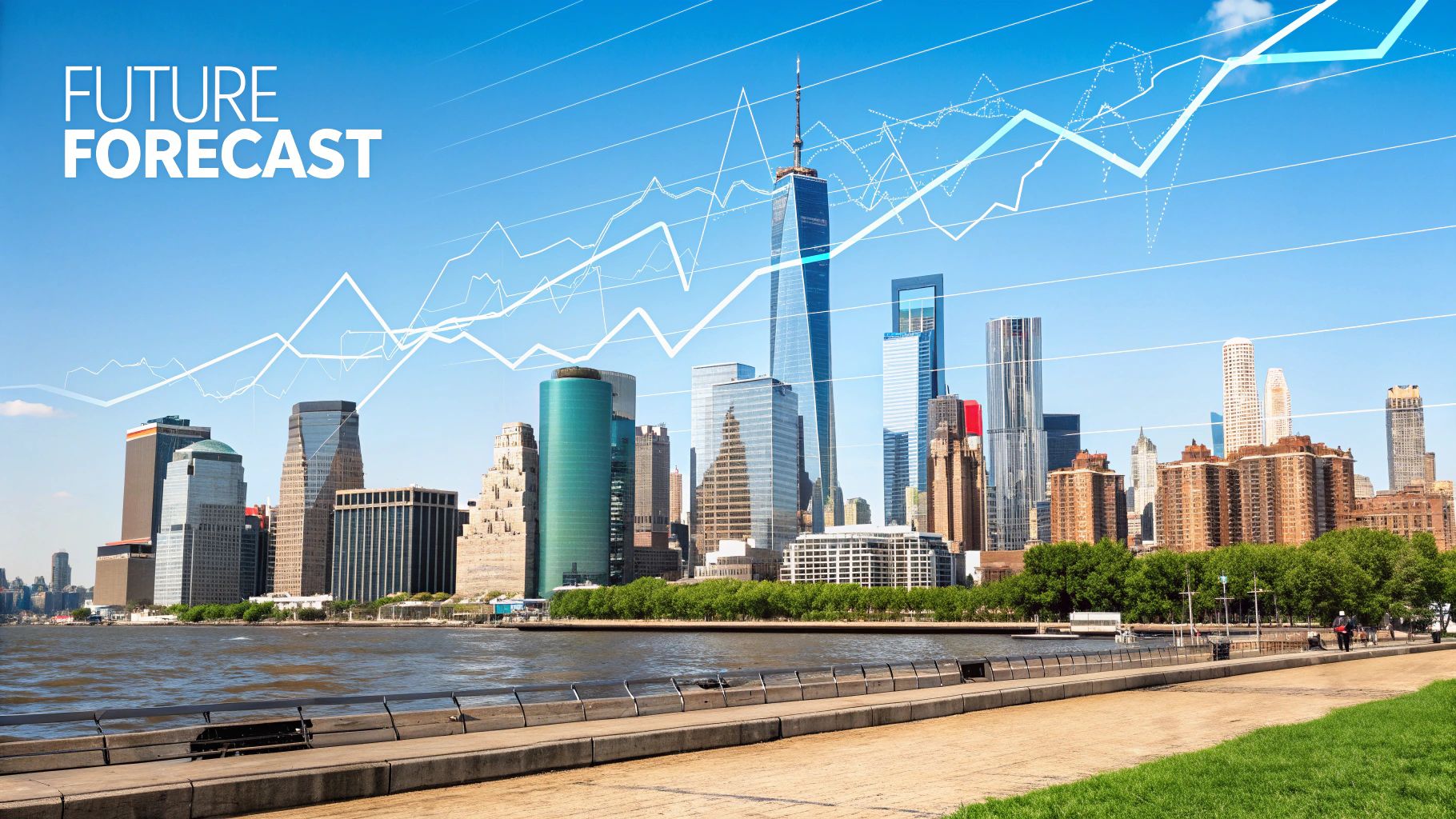
As we wrap up, you probably have a few questions buzzing around. That’s completely normal. This is a complex topic, so let's clear the air and tackle some of the most common things traders ask when they start looking into AI.
We're going to cut through the noise and give you some straight answers. Think of this as a quick debrief to help you feel confident about what AI can—and can't—do for your trading.
In a word: no. Let's be crystal clear about this. While AI is a massive leap forward for analyzing markets, it’s not a magic money-making machine. The forex market is wild, driven by everything from political shake-ups to surprise economic reports. Nothing can predict the future with 100% accuracy.
Think of AI as your co-pilot, not the autopilot. It helps you see the market more clearly, make decisions without emotional bias, and spot patterns a human eye would miss. But risk is always part of the game. You still need a solid trading plan and disciplined risk management to succeed. Losses are inevitable; the goal is to manage them effectively.
Thankfully, those days are long gone. Not too long ago, you'd need a background in programming or quantitative analysis to even think about algorithmic trading. The whole space was locked away for the pros.
Now, things are different. Tools like EzAlgo are designed to plug right into familiar platforms like TradingView. You get all the power of advanced AI signals, trend analysis, and momentum alerts without ever touching a line of code. The job isn't to build the engine anymore; it's to learn how to drive it by interpreting the signals on your chart.
The biggest risk is not the technology itself, but blind faith in it. A trader's critical oversight, paired with the AI's analytical power, creates the strongest combination. Never assume an AI tool can run perfectly without your supervision and strategic input.
This is a really important distinction to make. A basic trading robot, which you might know as an Expert Advisor (EA), is pretty rigid. It follows a simple, pre-programmed set of rules. For example: "If X happens, then do Y." It can't think for itself or adapt when the market changes its tune.
A genuine AI for forex trading is a whole different beast. It’s dynamic because it can learn from new information. As the market evolves, a machine learning model can spot new patterns and adjust its analysis on the fly.
Put simply, a basic robot is stuck with its original instructions. A true AI learns and gets smarter over time. That ability to adapt is what gives it a serious advantage.
Ready to stop guessing and start trading with data-driven precision? EzAlgo provides the AI-powered tools you need to identify high-probability setups, manage risk, and trade without emotion. See how our advanced indicators can transform your strategy on TradingView.